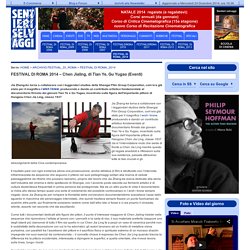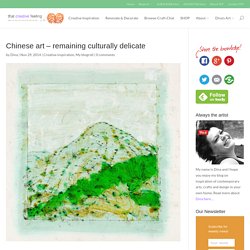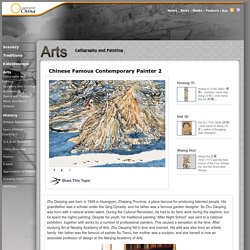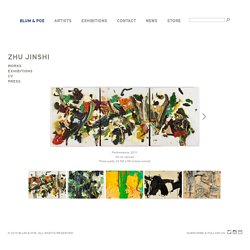

"The taller the bamboo grows, the lower it bends." Bada Shanren (八大山人; ‘Mountain Man of the Eight Greats’), was born as Zhu Da (朱耷), in 1626 into a family of scholars, poets, and calligraphers – the Yiyang branch of the Ming imperial family, in Nanchang, Jiangxi province, the traditional residence of the Yiyang prince.

He was a purported child prodigy and began writing poetry and painting at a very early age. Zhu Da’s childhood was untroubled and idyllic. However the peaceful world of his youth was shattered to pieces by the violent rise of the Manchus. He was about eighteen years old when the Manchus took over Beijing and nineteen when Manchu forces occupied Nanchang. Chinese book reviews. The Art of Lingnan School. FESTIVAL DI ROMA 2014 – Chen Jialing, di Tian Ye, Gu Yugao (Eventi) Jia Zhang-ke torna a collaborare con i leggendari studios della Shangai Film Group Corporation, com’era già stato per il magnifico I wish I knew, producendo e dando un contributo artistico fondamentale al documentario firmato dai giovani Tian Ye e Gu Yugao, incentrato sulla figura dell’importante pittore di Hangzou Chen Jia Ling, classe 1937.

Jia è l’intervistatore muto che siede di fronte a Chen Jia Ling mentre questo gli regala aneddoti e riflessioni sulla sua esistenza, passata attraverso tutte le fasi cruciali e gli stravolgimenti della Cina contemporanea.
Chinese art. Chinese art has seen a phenomenal growth in the art market globally.

Contemporary Chinese artists are attracting huge sales however there is a lot of caution around forgeries and fakes. Despite the swinging hype and alert, these Chinese artists have continued to find a delicate balance between what we would normally associate as traditional Chinese art yet with a modern edge. Mr. Chinese Famous Contemporary Painter 2 - China culture. Zhu Daoping was born in 1949 in Huangyan, Zhejiang Province, a place famous for producing talented people.

His grandfather was a scholar under the Qing Dynasty, and his father was a famous garden designer. So Zhu Daoping was born with a natural artistic talent. During the Cultural Revolution, he had to do farm work during the daytime, but he spent the nights painting. Despite his youth, his traditional painting “After Night School” was sent to a national exhibition, together with works by a number of professional painters. This caused a sensation at the time. When he was very young, Zhu Daoping and his parents moved to Nanjing, the ancient capital that used to be known as Jinling.
The Art Of Feng Zikai Feng Zikai. With “Imperishable Affection: The Art of Feng Zikai,” the Hong Kong Museum of Art quietly pulled off something of a coup in assembling a comprehensive selection of work by Feng Zikai (1898–1975), the artist recognized in his lifetime as the “father of Chinese cartoons.”

This presentation also signaled the potential for Feng’s work to appeal to audiences beyond the Chinese-speaking world, spreading a humanistic message of compassion and humility. Imperishable Affection: The Art of Feng Zikai - Creating a World of Compassion. In 2012, Hong Kong Museum of Art presents a series of cartoon works by Feng Zikai (1898-1975), who has been referred to as the 'Father of Chinese Cartoons.' 'Feng introduced the genre he called "manhua" (cartoons) into China, and "Zikai's Cartoons" became his iconic style.

He thought that both the form and the content of cartoons must carry spontaneity and immediacy. Only when the humanistic touch is felt in a cartoon can it touch its audience, regardless of their cultural and education background. Changshi Wu - FLOWERS, 1917, Ink and color on... China Heritage Quarterly. Pierre Ryckmans In 1996, Pierre Ryckmans (Simon Leys) presented the ABC Boyer Lectures.

Subsequently published under the title The View from the Bridge the lectures are now being serialised in China Heritage Quarterly with the permission of the author. Herewith we present the second essay, Reading. For the Introduction and the first essay, Learning, see here. Links to articles on reading and libraries published in previous issues of China Heritage Quarterly can be found at the end of this essay.
Beijing-based artist Zhu Jinshi’s first presentation in the United States is on view at Blum & Poe. Featuring twenty years of painting by Beijing-based artist Zhu Jinshi, his new solo exhibition presented by Blum & Poe is on view from June 1st through to July 7th.

This marks Zhu Jinshi’s first solo presentation in the United States, as well as his inaugural exhibition with Blum & Poe. Zhu Jinshi’s dynamic, nearly sculptural paintings avoid easy classification, defining themselves instead through an inherent physicality and visceral power. Zhu’s innovative style of painting (the aggressive application of massive amounts of oil paint and the employment of spatulas and shovels as his primary painting tools) retains a strong historical link to traditional Chinese mark making, while simultaneously finding a place within the canon of western action painting. Dramatically ranging in scale and palette, several works on view span more than ten feet tall, while others find their rhythm on a more intimate scale, often as diptychs or triptychs. Related posts: Zhu Jinshi. Born in Beijing, China, 1954 EducationArtists-in-Berlin Residency Program scholarship, German Academic Exchange Service (DAAD), 1988Architecture Department lectureship at Berlin Technical University, Germany, 1994Artist residency at the Banff Center, Canada, 1998 Lives and works in Beijing, China One-Person Exhibitions.

Alisan Fine Arts.